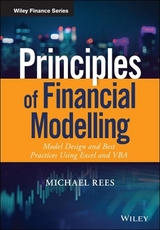
Financial Modelling in Practice
John Wiley & Sons Inc (Verlag)
978-0-470-99744-4 (ISBN)
- Lieferbar
- Versandkostenfrei
- Auch auf Rechnung
- Artikel merken
Financial Modelling in Practice: A Concise Guide for Intermediate and Advanced Level is a practical, comprehensive and in-depth guide to financial modelling designed to cover the modelling issues that are relevant to facilitate the construction of robust and readily understandable models. Based on the authors extensive experience of building models in business and finance, and of training others how to do so this book starts with a review of Excel functions that are generally most relevant for building intermediate and advanced level models (such as Lookup functions, database and statistical functions and so on). It then discusses the principles involved in designing, structuring and building relevant, accurate and readily understandable models (including the use of sensitivity analysis techniques) before covering key application areas, such as the modelling of financial statements, of cash flow valuation, risk analysis, options and real options. Finally, the topic of financial modelling using VBA is treated. Practical examples are used throughout and model examples are included in the attached CD-ROM.
Aimed at intermediate and advanced level modellers in Excel who wish to extend and consolidate their knowledge, this book is focused, practical, and application-driven, facilitating knowledge to build or audit a much wider range of financial models.
Note: CD-ROM/DVD and other supplementary materials are not included as part of eBook file.
Michael Rees gained a BA with First Class Honours and a Doctorate in Mathematics from Oxford University in 1985 and 1988 respectively. In 1992 he gained an MBA with Distinction from INSEAD, and in 2003 graduated in first position on the Certificate in Quantitative Finance program, also winning the Wilmott award. Since 2002 Michael has worked independently as a consultant and trainer in financial modelling. Prior to this he worked as a strategy consultant with Braxton Associates and Mercer Management Consulting, and also as an analyst at J.P. Morgan. Michael lives in Richmond, UK. He was born in Canada, has lived in several countries, and is fluent in French and German.
Background, Objectives and Approach xv
About the Author xix
Acknowledgements xxi
1 Building Blocks: Selected Excel Functions and Tools 1
Core Functions for Financial Modelling 1
Arithmetic Operations 1
Logical Operations 3
Financial Calculations 6
Database Functions, Features and Pivot Tables 12
Statistical Functions 16
Lookup and Reference Functions 20
Text Functions 29
Information Functions 33
Array Functions, Formulae and Matrix Calculations 35
GoalSeek and Solver 40
The Analysis ToolPak and Other Add-ins 43
The Analysis ToolPak 44
Selected Excel Short-cuts 47
2 Principles of Modelling 49
What is a Good Model? 49
Model Design 50
Selection of Model Variables and their Dependencies 50
Hyper Sensitivity to a Variable 55
Level of Detail or Aggregation 55
Model Structure and Planning 60
Logical Flow 60
Compactness 62
Named Ranges 64
Circular References 69
Model Building 74
Formatting and Comments 74
Creating Robust Formulae 78
Results Presentation and Other Uses of Sensitivity Analysis 85
General Remarks on Presentation 86
Using Data Tables to Conduct Sensitivity Analysis 86
Hiding and Protecting Models 92
Model Auditing 94
3 Financial Statement, Cash Flow and Valuation Modelling 99
Financial Statement Modelling: Core Points and Example 99
General Comments 100
Income Statement Forecasting 102
Balance Sheet Forecasting 107
Cash Flow Statement Forecasting 110
Error Checks and Feasibility Checks 111
General Error Checking Tools 111
Feasibility Checking and Ratio Analysis 113
Adding Generality 116
Cash Flow Valuation 120
Calculation of Free Cash Flow 121
Discounting Free Cash Flow 121
Terminal Value Calculations 124
Further Adjustments 128
Sensitivity Analysis 129
4 Risk Modelling 133
Benefits and Challenges of Risk Modelling 133
The Risk Modelling Process 135
An Introduction to Simulation Techniques 136
The Language of Probability Distributions 137
Quick Guide to using @RISK 142
Types of Dependency Relationships in Risk Models 144
The Selection and Use of Distributions 147
Pragmatic Approaches and Distributions 148
Data-Driven Approaches and Distributions 153
Scientific Approaches and Distributions: The Basics 155
Further Aspects of the Science of Distributions 163
Further Example Models 167
5 Introduction to Options and Real Options Modelling 181
Financial Market Derivatives: An Introduction 181
Real Options Modelling 188
Uses and Relationships to Other Types of Analysis 189
6 VBA for Financial Modelling 203
Introduction 203
The Bare Essentials 204
Simple Examples 208
Building Blocks 212
Working with Ranges 212
Writing Robust Code 220
Further Topics 224
Object Orientation: An Introduction 224
Controlling Execution and Related Topics 227
Working with Functions 230
Checking and Debugging Code 232
Examples: Recording Macros and Related Topics 235
Introduction 235
Using GoalSeek and Solver 237
Examples: Simulation Modelling 240
Introduction 240
Examples: User-defined Functions 243
Creating Functions 243
Examples 244
Structure and Organisation: Further Topics 248
Further Reading 253
Index 255
| Reihe/Serie | Wiley Finance Series |
|---|---|
| Verlagsort | New York |
| Sprache | englisch |
| Maße | 175 x 252 mm |
| Gewicht | 744 g |
| Themenwelt | Wirtschaft ► Betriebswirtschaft / Management ► Finanzierung |
| ISBN-10 | 0-470-99744-3 / 0470997443 |
| ISBN-13 | 978-0-470-99744-4 / 9780470997444 |
| Zustand | Neuware |
| Informationen gemäß Produktsicherheitsverordnung (GPSR) | |
| Haben Sie eine Frage zum Produkt? |
aus dem Bereich



